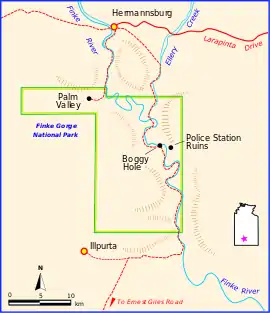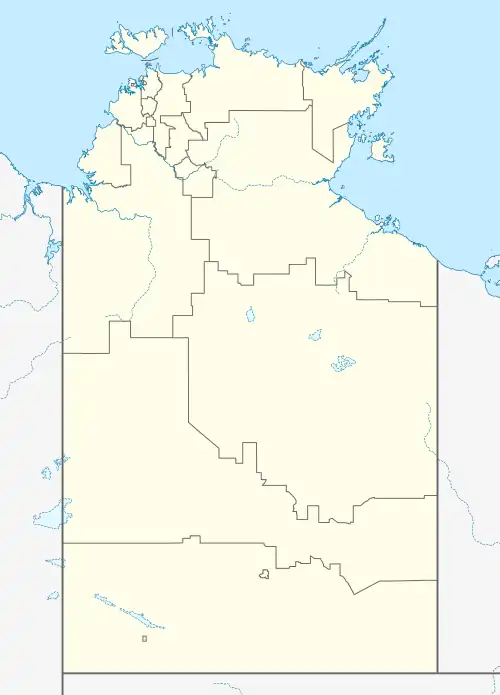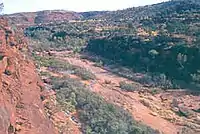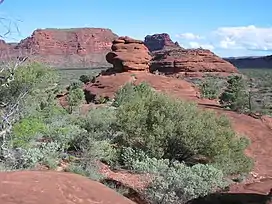| Finke Gorge National Park Namatjira[1], Northern Territory | |
|---|---|
IUCN category V (protected landscape/seascape)[2] | |
 Finke Gorge National Park map | |
 Finke Gorge National Park | |
| Nearest town or city | Alice Springs |
| Coordinates | 23°40′00″S 132°39′00″E / 23.6667°S 132.65°E[1] |
| Established | 28 October 1966[2] |
| Area | 452.85 km2 (174.8 sq mi)[3] |
| Visitation | 19,900 (in 2018)[4] |
| Managing authorities | |
| Website | Finke Gorge National Park |
| See also | Protected areas of the Northern Territory |
Finke Gorge National Park is a protected area in the Northern Territory of Australia located about 1,318 kilometres (819 mi) south of the territory capital of Darwin.[5] The national park covers an area of 458 km2 (177 sq mi), and includes the desert oasis Palm Valley, home to a diverse range of plant species, many of which are rare and unique to the area. There are good opportunities for bushwalking and bushcamping in the national park.[6]
Heritage
The national park is noted for its ancient palms and Aboriginal cultural sites. The Central Australian Cabbage Palm is found only in Palm Valley and prolifically here.[6] There are around 3000 full grown palms and thousands of small seedlings sprinkled across the park which can get easily trampled by the visitors. Thus the visitors are required to walk along the marked paths to avoid destroying the seedlings.[7] The Finke River is claimed to be one of the oldest catchments in the world,[6] with areas dating back 350 million years.
The national park and nearby areas hold cultural significance to the Western Arrernte Aboriginal people[8] and there is also evidence of early European settlement.[9]
In 1980, it was listed on the now-defunct Register of the National Estate.[10]
Access
A four-wheel-drive route down the Finke River to Illamurta Springs and Watarrka National Park begins at Finke Gorge. Bush walking is another common activity. Kalaranga lookout is an easy 20 minute climb, with views of the rock amphitheatre encircled by rugged cliffs. The Mpaara Walk introduces the mythology of the Western Arrernte Aboriginal culture. In Palm Valley, the Arankaia Walk and the longer Mpulungkinya Walk meander among slender palms, returning across a scenic plateau.
Gallery
 Palm Valley, located in the national park
Palm Valley, located in the national park Amphitheatre
Amphitheatre
See also
References
- 1 2 "Place Names Register Extract for "Finke Gorge National Park"". NT Place Names Register. Northern Territory Government. Retrieved 7 October 2019.
- 1 2 "Terrestrial Protected Areas Detailed List in Northern Territory (2018)". CAPAD 2018. Australian government. Retrieved 3 April 2020.
- ↑ NT Parks and Reserves List (PDF), Parks and Wildlife Commission of the Northern Territory, 31 May 2019, retrieved 5 April 2020
- ↑ "NT parks and reserves - Calendar Year Visitor Numbers". Department of Tourism, Sport and Culture. Northern Territory Government. Retrieved 5 April 2020.
Traffic counter located at entry to Palm Valley.
- ↑ Hema, Maps (2007). Australia Road and 4WD Atlas (Map). Eight Mile Plains Queensland: Hema Maps. p. 100. ISBN 978-1-86500-456-3.
- 1 2 3 Hema Maps (1997). Discover Australia's National Parks. Milsons Point, New South Wales: Random House Australia. p. 221. ISBN 1-875992-47-2.
- ↑ "Finke Gorge National Park". Northern Territory Government.
- ↑ https://dtsc.nt.gov.au/__data/assets/pdf_file/0010/249148/finke-gorge-national-park.pdf Particularly page 6 and following
- ↑ https://nt.gov.au/__data/assets/pdf_file/0012/200037/finke-gorge-national-park-fact-sheet.pdf%5B%5D Particularly note the "Police Station Ruins"
- ↑ "Finke Gorge National Park, Hermannsburg,(sic) NT, Australia - listing on the now-defunct Register of the National Estate (Place ID 192)". Australian Heritage Database. Australian Government. 21 October 1980. Retrieved 6 April 2020.